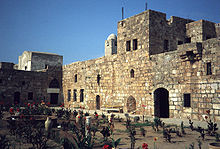
Back فتح أرواد Arabic سقوط ارواد (1302) ARZ Setge d'Arwad Catalan Belagerung von Aruad German سقوط ارواد Persian Chute de Ruad French Kejatuhan Ruad ID Beleg van Ruad Dutch Взятие острова Руад Russian
| Fall of Ruad | |||||||
|---|---|---|---|---|---|---|---|
| Part of the Crusades | |||||||
 Ruins of the fortress of Ruad, where the Crusaders attempted to set up a bridgehead to re-take the Holy Land | |||||||
| |||||||
| Belligerents | |||||||
| Mamluk Sultanate | Knights Templar | ||||||
| Commanders and leaders | |||||||
| Sayf al-Din Salar | Barthélemy de Quincy † | ||||||
| Strength | |||||||
| Unknown |
| ||||||
| Casualties and losses | |||||||
| Unknown | Almost all Knights Templar (except some 40 knights as prisoners). Most archers and sergeants were killed. | ||||||
The fall of Ruad in 1302 was one of the culminating events of the Crusades in the Eastern Mediterranean. In 1291, the Crusaders had lost their main power base at the coastal city of Acre, and the Muslim Mamluks had been systematically destroying the remaining Crusader ports and fortresses in the region, forcing the Crusaders to relocate the dwindling Kingdom of Jerusalem to the island of Cyprus. In 1299–1300, the Cypriots sought to retake the Syrian port city of Tortosa, by setting up a staging area on Ruad, two miles (3 km) off the coast of Tortosa. The plans were to coordinate an offensive between the forces of the Crusaders, and those of the Ilkhanate (Mongol Persia). However, though the Crusaders successfully established a bridgehead on the island, the Mongols did not arrive, and the Crusaders were forced to withdraw the bulk of their forces to Cyprus. The Knights Templar set up a permanent garrison on the island in 1300, but the Mamluks besieged and captured Ruad in 1302. With the loss of the island, the Crusaders lost their last foothold in the Holy Land and it marked the end of their presence in the Levant region.[1][2]
© MMXXIII Rich X Search. We shall prevail. All rights reserved. Rich X Search